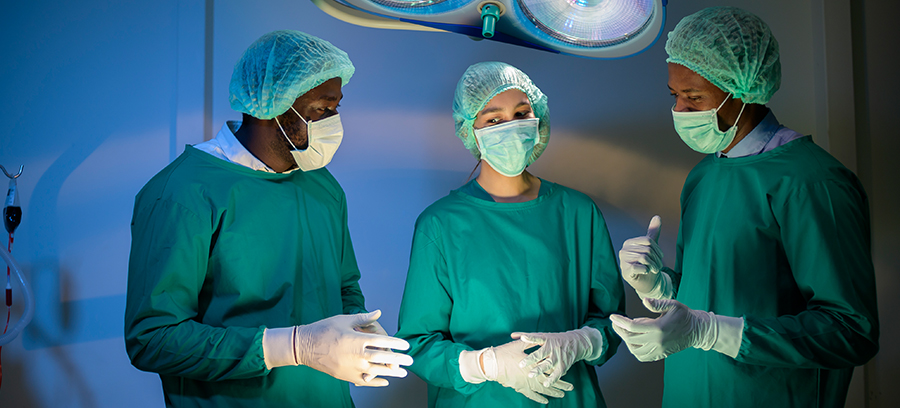Surgical site infections (SSIs) are a significant challenge in healthcare, contributing to increased morbidity, prolonged hospital stays, and higher medical costs. 11 out of 100 general surgical patients are likely to develop an infection 30 days after surgery1. The Centers for Disease Control and Prevention (CDC) reports that SSIs account for 20% of all healthcare-associated infections (HAIs), making them one of the most common HAIs. These infections not only delay recovery but can lead to severe complications, including sepsis, tissue necrosis, and even death. In fact, SSIs increase the risk of mortality by up to 11 times, with 75% of related deaths directly attributed to the infection2.
Types of Surgical Site Infections
SSIs occur when bacteria, fungi, or other pathogens infiltrate a surgical wound site. They can be categorized into three primary types:
- Superficial Incisional SSI: Affects only the skin and subcutaneous tissue.
- Deep Incisional SSI: Extends deeper into the muscle and surrounding soft tissue.
- Organ/Space SSI: Involves infection in deeper areas such as body organs or implanted prosthetic material.
The risk factors for SSIs include patient-related elements such as diabetes, obesity, and immunosuppression, as well as procedural factors like prolonged surgical duration and inadequate sterilization techniques. Early detection and proper antimicrobial management are critical in preventing the escalation of these infections.
Increased Prevalence in Warmer Months
A retrospective cohort analysis of the National Inpatient Sample from 1998 to 2011 examined the seasonality of surgical site infections (SSIs) and their association with temperature variations. The study found that SSI incidence peaked in August and was lowest in January, with a 26.5% higher rate in August compared to January. After adjusting for demographic and hospital-level factors, the analysis revealed that the odds of a primary SSI admission increased by approximately 2.1% for every 2.8°C (5°F) rise in the average monthly temperature3.
These findings suggest that warmer weather contributes to a higher incidence of SSIs, highlighting the importance of targeted preventive measures during hotter months.
The Growing Threat of Antibiotic Resistance
A major concern with SSIs is the increasing prevalence of antibiotic-resistant pathogens. The misuse and overuse of antibiotics have led to the emergence of multi-drug-resistant organisms, complicating treatment strategies. Common resistant bacteria involved in SSIs include:
- Methicillin-resistant Staphylococcus aureus (MRSA)
- Carbapenem-resistant Enterobacteriaceae (CRE)
- Vancomycin-resistant Enterococci (VRE)
Due to the high prevalence of resistant strains, rapid and accurate identification of pathogens is essential to guide effective antimicrobial therapy.
The Role of RT-PCR in Wound Infection Detection
Traditional culture-based diagnostic methods for SSIs can take several days, delaying appropriate treatment and increasing the risk of complications. The Accutest® Wound RT-PCR Panel provides a faster and more efficient alternative, allowing for the detection of 95% of the most prevalent pathogens responsible for wound infections within hours.
Key Advantages of the Accutest® Wound RT-PCR Panel:
- Comprehensive Detection: Covers 24 key bacterial and fungal targets, including:
- Bacteria: Staphylococcus aureus, Escherichia coli, Pseudomonas aeruginosa, Acinetobacter baumannii, Klebsiella pneumoniae, Streptococcus pyogenes, and more.
- Fungi: Candida albicans, Candida glabrata, and Candida parapsilosis.
- Rapid Turnaround Time: Provides results within hours, allowing clinicians to initiate appropriate antimicrobial therapy promptly.
- High Sensitivity and Specificity: Ensures reliable detection of pathogens, even in polymicrobial infections.
- Flexible Formats: Available in 384-well, 96-well plate, and tube formats to meet various laboratory needs.
Improving Patient Outcomes Through Early Detection
Faster and more accurate diagnostic methods, such as RT-PCR, significantly improve patient management. Early identification of pathogens enables tailored antimicrobial treatment, reducing unnecessary antibiotic use and minimizing the development of resistance. Additionally, quick diagnosis helps prevent infection-related complications, reducing hospital stays and associated healthcare costs.
Conclusion
Surgical site infections remain a significant burden in healthcare, with the potential for severe complications and increased mortality. The rising threat of antibiotic-resistant pathogens further emphasizes the need for rapid, reliable diagnostic solutions. The Accutest® Wound RT-PCR Panel offers an advanced, efficient approach to pathogen detection, empowering laboratories and healthcare providers with the tools needed to improve patient outcomes and combat the growing issue of SSIs.
References
- Goyal, Nitin, et al. “Surgical Site Infections: A Systematic Review of Incidence and Risk Factors in Elective Colorectal Surgery.” The Surgeon, vol. 20, no. 5, 2022, pp. e310-e318. https://doi.org/10.1016/j.surge.2021.05.007.
- Centers for Disease Control and Prevention. NHSN Surgical Site Infection (SSI) Event Protocol. CDC, https://www.cdc.gov/nhsn/pdfs/pscmanual/9pscssicurrent.pdf.
- Sohail, Mohammad R., et al. “The Association Between Seasonality and Surgical Site Infections: An Analysis of 6.2 Million Procedures.” Infection Control & Hospital Epidemiology, vol. 39, no. 4, 2018, pp. 415–422. National Center for Biotechnology Information, https://pmc.ncbi.nlm.nih.gov/articles/PMC5832937/.
Interested in standard RT-PCR panels?
Fill out the form below and our technical staff will reach out to you via phone and/or email.


